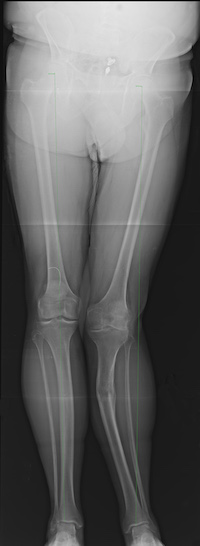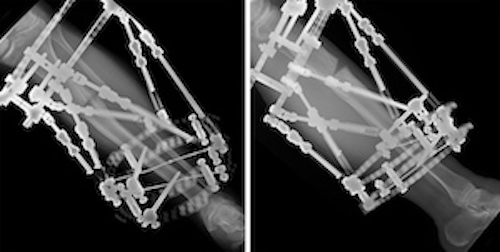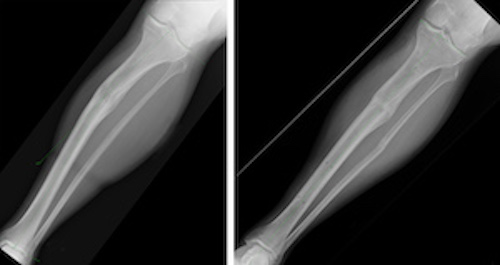 Since sustaining leg trauma in a motorcycle accident more than 15 years ago, an active man in his 50s had grown accustomed to experiencing debilitating knee pain on a daily basis. His left tibia had healed with a significant fracture malunion, and as a result, he had been developing progressive focal knee arthritis.
Since sustaining leg trauma in a motorcycle accident more than 15 years ago, an active man in his 50s had grown accustomed to experiencing debilitating knee pain on a daily basis. His left tibia had healed with a significant fracture malunion, and as a result, he had been developing progressive focal knee arthritis.
The patient presented to Duke Orthopaedics for a knee replacement assessment, considering this the best course of action to improve his quality of life. However, the longtime tibial malunion made him a poor candidate for the surgery. He was then referred internally to Mark Gage, MD, orthopaedic trauma surgeon, who saw an opportunity to correct the patient’s alignment issues while avoiding knee surgery altogether.
Question: What surgical treatment plan did Gage pursue to correct this skeletal deformity?
Answer: Over a period of three months, Gage used a circular external fixation frame and osteotomy to slowly straighten out the patient’s tibia and restore his mechanical axis. The patient returned at weekly intervals initially before gradually increasing the time between visits, reporting reduced knee pain as the treatments continued.
 “Due to the patient’s overall limb alignment, the tremendous amount of underlying arthritis had created an uneven amount of contact stress on the patient’s knee and across the associated joints,” Gage explains. “Once we began correcting the skeletal deformity, we were able to alleviate much of the patient’s pain, discomfort, and limitations associated with his knee pain.”
“Due to the patient’s overall limb alignment, the tremendous amount of underlying arthritis had created an uneven amount of contact stress on the patient’s knee and across the associated joints,” Gage explains. “Once we began correcting the skeletal deformity, we were able to alleviate much of the patient’s pain, discomfort, and limitations associated with his knee pain.”
The contact stress had been redistributed across a large surface area, which offloaded the area of focal arthritis; this meant that the patient’s left knee had been well preserved, eliminating the need for knee replacement surgery, Gage says. After several months, the patient reported no knee pain and was able to return to everyday activities, including exercising and playing sports with his family.
“What often happens with patients who have traumatic injuries to their extremities is that when their acute care outcomes are not as positive as they anticipated, they go on assuming that this is just how life is going to be from now on,” Gage explains. “But we’re demonstrating that there is certainly more that the Trauma Division can do to help people improve their function, pain, and prognosis.”
 While not common in adults, this type of deformity is more often seen by the Duke Division of Pediatric Orthopaedics during skeletal development or after trauma, Gage says. “Adults are not presenting as frequently because they tend to have lived with the malalignment for a long time, but it’s more common than we realize,” he adds.
While not common in adults, this type of deformity is more often seen by the Duke Division of Pediatric Orthopaedics during skeletal development or after trauma, Gage says. “Adults are not presenting as frequently because they tend to have lived with the malalignment for a long time, but it’s more common than we realize,” he adds.
Duke offers treatment options to help patients who are experiencing significant issues post-trauma—whether that’s deformity, pain, infection, or surgery. “Duke’s coordination of care is attuned to these types of injuries,” Gage says. “It’s a matter of knowing where to send these patients. We have a great team of physicians here at Duke that successfully treat these complex deformities.”